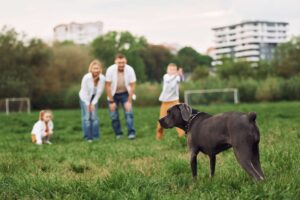






I’ve worked with protection dogs for years. It’s not just a job; it’s a calling. From intense training sessions to watching these incredible dogs perform with undying loyalty and skill, I’ve seen firsthand what it takes to shape a top-tier working dog.
But today, we’re shifting the focus. Let’s talk about something that often goes unspoken in the working dog world: helping these loyal partners retire gracefully.
This isn’t a blanket discussion for all working line breeds—it’s a conversation tailored to those most often seen in protection work: German Shepherds (GSD), Belgian Malinois, Rottweilers, and a few other powerhouses.
These dogs give their all, but when the time comes for them to step back from their duties, they need just as much guidance and care as they did during their prime.
So, how do you go about it?
Protection dogs are trained to push through fatigue, discomfort, and even pain. Their loyalty and drive can keep their engines running even when their bodies aren’t fully capable of keeping up. It’s up to us, their handlers and caregivers, to make the tough call.
Look for subtle changes:
Age isn’t the only factor here. A younger dog might need to retire early due to health concerns or a traumatic experience that affects their performance.
The key is to observe your dog closely and listen to what they’re telling you. Consult your vet and trainer for a comprehensive assessment of their health, behavior, and suitability for continued work.
Protection dogs thrive on structure. When retirement rolls around, ripping that structure away can leave them confused or anxious. Instead, aim for a gradual transition.
Start by dialing back the intensity of their tasks. Replace high-stakes training sessions with activities they enjoy—like gentle walks, puzzle toys, or games of tug. Keep feeding and exercise schedules consistent to provide a sense of familiarity.
At the same time, introduce new elements that reflect their retired status.

While they might not be up for grueling training sessions, retired dogs still benefit from tailored physical activities. Low-impact exercises like swimming or gentle walking can keep them fit without straining their joints.
Just because they’re retired doesn’t mean they can’t have a job. Assign light tasks like fetching the newspaper or carrying small items. These activities give them a sense of accomplishment without overexertion.
While protection dogs often have limited interactions outside their immediate circle, retirement can be a great time to safely expand their social world.
Short, positive interactions with other dogs or friendly humans can help them feel more relaxed and balanced. Plus, this interaction can reduce feelings of isolation and maintain their social skills.
Your dog’s job wasn’t just physical—it was deeply emotional. They were your protector, your confidant, and often, your shadow. Stepping out of that role can leave them feeling a little lost.
This is where you step in. Spend quality time with your dog, not just as their handler but as their friend. This transition calls for gentle reassurance and consistent emotional support.
While their formal duties may be changing, your relationship can grow even stronger through new forms of connection.
Engage with them in ways that reinforce your bond—whether it’s sharing quiet moments together, taking leisurely strolls where they can stop to sniff and explore, or finding new gentle activities you both enjoy.
Above all, show them this: while their job might have changed, their place in your heart never will.
As your dog transitions into retirement, their diet might need a little fine-tuning to match their changing lifestyle.
With lower activity levels, senior dogs require fewer calories to maintain a healthy weight. Overfeeding can lead to obesity, which puts extra strain on aging joints and increases the risk of other health issues.
Consider foods that are easier to digest—your senior pup will thank you. Wet food can be a great option; its higher water content supports kidney health, and its softer texture is kinder to aging teeth.
If your dog has specific medical conditions, their diet may need further adjustments, including supplements like fish oil to help reduce joint inflammation and keep them comfortable.
Partner with your veterinarian to develop a diet plan customized to your dog’s needs. Whether it’s supporting joint health, or meeting new nutritional requirements, regular check-ups are essential to staying ahead of age-related concerns.
And don’t skimp on grooming. Older dogs may not shed as much or be as active, but their coats and nails still need attention.
Regular grooming isn’t just about keeping them clean—it’s an opportunity to check for lumps, bumps, or anything unusual.

And if your dog already lives indoors, the floor probably isn’t cutting it anymore. Hard surfaces aren’t exactly cozy, and the couch? That might be too much of a leap these days. The solution? Invest in thick, high-quality dog beds.
For dogs with joint issues like arthritis, an orthopedic bed or memory foam option can work wonders for their achy joints.
Want to take it up a notch? Try a heated bed or add a heating pad on top. These can help ease stiffness and keep your pup warm, perfect for dogs who feel the chill more as they age.
One more thing: senior protection dogs might not say it outright, but navigating their surroundings can become a real challenge as they age. Things they once did effortlessly, like hopping into the car or climbing stairs, might now seem impossible. Slippery hardwood floors and steep staircases? Those can knock their confidence, too.
Your older pup would love a little help to move around safely. Start by adding carpets or runners in high-traffic areas for better traction.
Got hardwood or tile floors? Lay down a yoga mat or anti-slip rug pads, especially near food and water dishes where slips can happen.
And for those moments when they need a lift, pet stairs or ramps make a huge difference—whether it’s getting onto the couch or into the car.
In some cases, a handler or family may not be able to provide the ideal retirement environment for their dog. This is a tough decision, but not necessarily a bad one.
The key is ensuring the dog transitions to a home where they’ll be loved and well cared for.
As hard as it is to think about, retirement is often the beginning of the final chapter for many protection dogs. The bond you share with your dog means you’ll likely outlive them, and it’s important to be prepared for that day.
So, focus on giving them the best possible life in their remaining years. And the hardest part?
Know when to let go. It’s one of the hardest decisions you’ll ever make, but knowing when to say goodbye is an act of love. Consult with your vet, trust your instincts, and prioritize their comfort and dignity.
The retirement of a protection dog is a bittersweet milestone—an end to their years of loyal service, yet a beginning to a well-deserved life of relaxation and care.
Now, each dog’s journey into retirement is different, shaped by their personality, past experiences, and physical needs. What remains constant is the role you play in making this transition as smooth and fulfilling as possible.
But here’s where most handlers mess up: They think retirement means their dog should just “figure it out.” Big mistake. Instead, think of retirement as a new mission.
Your dog needs three things:
It’s up to you to meet them where they are, celebrate their contributions, and honor this new chapter with the same commitment they’ve shown you over the years.
The truth bomb? This transition will test you both. You’ll have moments of doubt. Your dog might resist the change. That’s normal.
So, if the process feels overwhelming or you’re unsure what to do, there’s no shame in seeking expert guidance. Professionals ensure your protection dog transitions gracefully into their golden years.
At Vanguard Protection Dogs, we offer customized solutions based on your dog’s profile. Their age. Their drive level. Their service history. Everything.
Your next step: Book a call with our specialists today. We’ll lay out exactly how to give your guardian the retirement they deserve.